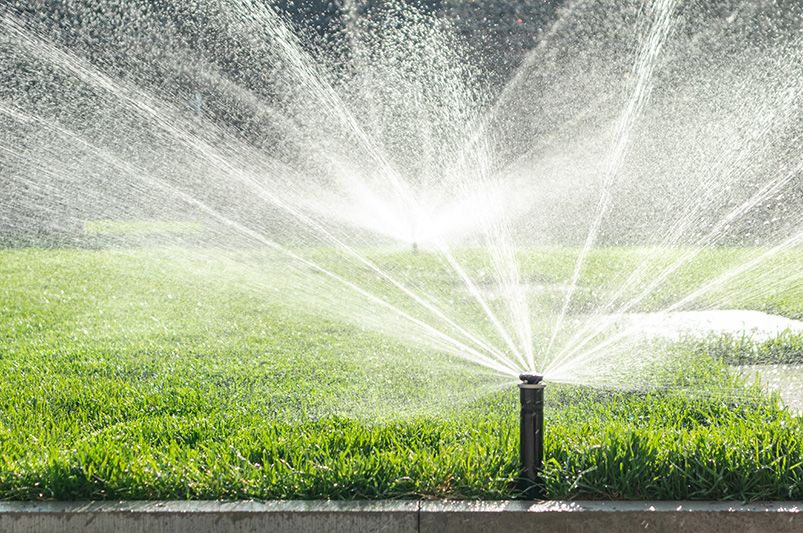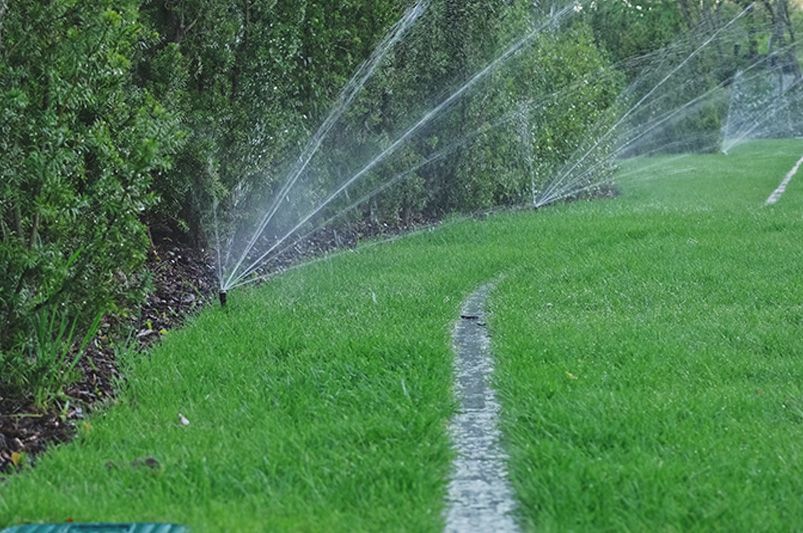
How to water your lawn correctly: The benefits of an irrigation plan
Published: 30/09/2024 | Updated: 25/09/2024
How to water your lawn correctly: The benefits of an irrigation plan
A lush, vibrant lawn is every homeowner's dream, but achieving that dream requires more than just regular mowing and fertilizing. One of the most critical factors in maintaining a healthy yard is proper watering. However, many homeowners struggle with finding the right balance—leading to common problems like overwatering, underwatering, or even unhealthy lawn diseases.


That’s where a well-structured irrigation plan can make all the difference. By ensuring your lawn gets the right amount of water, at the right time, you can save water, reduce costs, and keep your outdoor space thriving all year round. In this article, we’ll explore the benefits of setting up an irrigation plan, offer tips on how to water your lawn correctly, and help you avoid common pitfalls. And don’t forget to check out ShrubHub’s weekly blog, where we share expert gardening and landscaping tips to keep your yard looking its best!
Understanding Your Lawn's Water Needs
Every lawn is unique, and determining how much water yours requires depends on several key factors. A "one-size-fits-all" approach to lawn watering often leads to over or under watering, both of which can result in an unhealthy yard. To keep your lawn lush and thriving, it’s essential to understand the specific factors that influence its water needs.
1. Adapting to Local Weather Conditions
The climate in your region plays a major role in how much water your lawn will need. In warmer, arid climates, lawns tend to dry out faster and require more frequent watering to stay hydrated. On the other hand, if you live in a cooler, wetter area, natural rainfall may suffice for much of the year, reducing the need for additional watering. Seasonal changes also impact your lawn’s needs—what works in the heat of summer will be different from the cooler, rainy seasons.
For example, in hot summer months, your lawn will need deeper, more frequent watering to counteract heat stress. During cooler seasons, less frequent watering is ideal to avoid waterlogging and root rot. ShrubHub’s custom irrigation plans can help you adjust your watering schedule to match your local climate conditions, ensuring your lawn stays healthy throughout the year.

2. Soil Type
Your soil type also determines how much water your lawn can hold and how quickly it will drain. Sandy soils, for example, have larger particles that allow water to drain quickly, meaning you’ll need to water more frequently to keep moisture in the ground. On the other hand, clay soils hold water longer but are more prone to waterlogging, which can suffocate your lawn’s roots if not managed correctly.
Understanding your soil type is crucial in developing an effective irrigation plan. If you’re unsure of your soil composition, a soil test can help identify whether you need to adjust your watering habits. ShrubHub’s experts can provide personalized advice on watering based on your soil type and offer solutions like soil amendments to improve water retention or drainage.
3. Matching Watering to Grass Type
Different types of grass have varying water needs. Cool-season grasses like Kentucky bluegrass and fescue thrive in cooler temperatures and tend to need less water in the summer months. Meanwhile, warm-season grasses such as Bermuda grass and zoysia are more drought-resistant and can tolerate higher temperatures, requiring less frequent watering.
To optimize your lawn’s hydration, it’s important to match your watering practices to the type of grass you have. ShrubHub can assist in identifying your grass species and offer tailored watering schedules that keep your lawn healthy without wasting water.
4. Practical Tips: Spotting an Overwatered or Underwatered Lawn
Knowing when your lawn has had too much or too little water can save you from serious problems. Signs of overwatering include yellowing grass, a soggy surface, or the presence of fungi and pests. On the other hand, underwatered lawns tend to have brown, dry patches and may feel crunchy underfoot.
A good rule of thumb is to water deeply and less frequently to encourage deep root growth, ensuring your lawn can withstand dry periods. Additionally, if you notice water pooling on the surface, it’s a sign you’re watering too much at once. ShrubHub’s weekly blog offers more detailed tips on spotting early signs of over or underwatering, so be sure to subscribe and stay informed!
Benefits of an Irrigation Plan
Implementing a structured irrigation plan does more than just ensure your lawn gets the water it needs. It also offers several advantages that can save you time, money, and energy, all while promoting a healthier, more resilient lawn. Let’s explore the key benefits of having a well-thought-out irrigation plan.
A. Water Efficiency: Save Money and Resources
One of the greatest advantages of an irrigation plan is water efficiency. Without a proper system in place, it’s easy to overwater or waste water on areas that don’t need it, leading to higher utility bills and unnecessary resource use. A well-designed irrigation plan can reduce water wastage by delivering the right amount of water exactly where it’s needed, which helps you conserve water and lower your monthly bills.
For even greater efficiency, consider smart irrigation systems. These advanced systems use weather data, soil moisture levels, and timers to automatically adjust your watering schedule. This ensures your lawn gets the optimal amount of water based on real-time conditions, further reducing waste. ShrubHub offers a variety of smart irrigation solutions, customized to fit your landscape, helping you save water without sacrificing the health of your lawn.

B. Promotes Healthy Lawn Growth
Consistent, regulated watering is essential for promoting deep root development in your lawn. When you water erratically, either too much or too little, the roots remain shallow, making the grass more susceptible to stress from drought, heat, or foot traffic. An irrigation plan helps deliver water deeply and consistently, encouraging your lawn’s roots to grow deeper and stronger, resulting in a more resilient yard.
Additionally, precise watering patterns can prevent lawn diseases, which often arise from overwatering or allowing water to sit too long on the surface. By having an irrigation plan in place, you can ensure your lawn is not overexposed to moisture, thus minimizing fungal growth and other moisture-related diseases. With ShrubHub’s expertise in designing custom irrigation systems, you can be confident that your lawn will receive just the right amount of water to stay healthy and disease-free.
C. Time-Saving and Convenience
For busy homeowners, maintaining a consistent lawn-watering schedule can be challenging. This is where automated irrigation systems come to the rescue. By automating the watering process, you no longer have to worry about manually setting sprinklers or remembering to water on specific days. This convenience allows you to spend more time enjoying your outdoor space and less time maintaining it.
ShrubHub’s irrigation specialists can help design a custom irrigation schedule that works for your unique landscape. Whether you have a small garden or a sprawling yard, we’ll create a plan that optimizes water distribution and frees up your time, so you can focus on other priorities. Automated systems can even adjust based on the weather, saving you from having to make constant adjustments.
Types of Irrigation Systems to Consider
When it comes to choosing an irrigation system, not all lawns are created equal. Different landscapes require different solutions to ensure the most efficient and effective watering. Here, we’ll break down three main types of irrigation systems that can be customized to suit your yard’s needs, from traditional sprinklers to cutting-edge smart technology.
A. Sprinkler Systems
Sprinkler systems are one of the most common methods for watering lawns and come in various types, each suited for different lawn layouts.
-
Pop-up Sprinklers: These sprinklers are ideal for medium to large lawns. They remain hidden underground until they are activated, preventing them from becoming an eyesore when not in use. Pop-up sprinklers work best for flat, even lawns and are particularly efficient in covering large, uniform areas.
-
Rotary Sprinklers: Rotary sprinklers rotate in a circular pattern, covering wide areas with an even distribution of water. They are perfect for larger lawns with wide-open spaces. Rotary systems are known for their ability to deliver water more evenly and with less wind interference, making them a popular choice for homeowners looking to maximize water efficiency.
-
Oscillating Sprinklers: These sprinklers spray water in a fan-shaped motion and are ideal for small to medium-sized lawns or rectangular areas. Oscillating sprinklers are easy to set up and adjust but may not be as efficient for larger or more irregularly shaped spaces.
When choosing a sprinkler system, it’s essential to consider your lawn’s shape and size. ShrubHub’s irrigation experts can help assess your landscape and recommend the best sprinkler solution for even and effective water distribution.
B. Drip Irrigation Systems
Drip irrigation systems are designed for more targeted watering and are particularly effective in gardens or smaller areas where you want to minimize water wastage. This system works by slowly releasing water directly into the soil at the base of plants through tubes or pipes with small emitters.
The key benefit of drip irrigation is water conservation. Because the water is delivered directly to the root zone, it significantly reduces evaporation and runoff, making it highly efficient. Drip systems are ideal for flower beds, vegetable gardens, or areas with shrubs and trees that require more precise watering.
If you’re looking to save water while maintaining lush plant beds or garden areas, ShrubHub can help design a drip irrigation system tailored to your landscape’s specific needs.
C. Smart Irrigation Systems
For homeowners looking to combine efficiency with convenience, smart irrigation systems are a game-changer. These advanced systems use real-time data, such as weather forecasts, soil moisture levels, and even rainfall measurements, to adjust watering schedules automatically. Smart irrigation systems ensure your lawn gets the exact amount of water it needs based on the current conditions, eliminating the guesswork and helping you save on water usage.
With the ability to control these systems from your smartphone or tablet, smart irrigation technology offers ultimate flexibility, allowing you to monitor and adjust your watering schedule anytime, anywhere.
Conclusion
A well-planned irrigation system is the foundation of a healthy, vibrant lawn. By understanding your lawn’s unique water needs, choosing the right irrigation system, and maintaining a consistent watering schedule, you can ensure your yard stays green, beautiful, and stress-free. Whether you opt for traditional sprinkler systems, targeted drip irrigation, or the convenience of smart technology, the benefits of an efficient irrigation plan are undeniable.
At ShrubHub, we’re here to help you take your lawn care to the next level. Our expert services include creating a full 3D model of your dream yard, integrating a custom irrigation plan that works seamlessly with your landscape. We also connect you with reliable local contractors to professionally install your irrigation system and maintain your lawn’s health throughout the year.
Ready to make your outdoor space thrive? Schedule a consultation with ShrubHub today and let us design the perfect irrigation plan for your home. With our expert guidance, you’ll enjoy a greener, healthier lawn without the hassle!


